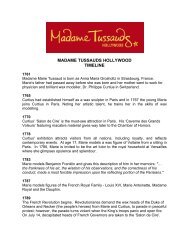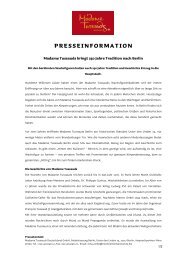What is a portrait? - Madame Tussauds
What is a portrait? - Madame Tussauds
What is a portrait? - Madame Tussauds
Create successful ePaper yourself
Turn your PDF publications into a flip-book with our unique Google optimized e-Paper software.
Activity 1<br />
Once you have developed a portfolio of sketches and your planning<br />
sheet, you are ready to create your sculpture, thinking about the<br />
following:<br />
Scale – how big will your piece be?<br />
Techniques – what techniques will you use to build the 3D form?<br />
Texture – will your piece be smooth or textured? Will some<br />
parts of the sculpture need a different texture like skin or hair?<br />
Colours – how will you fin<strong>is</strong>h off the surface of the piece?<br />
Will you stain it or paint it? D<strong>is</strong>cuss the possibilities with<br />
your teacher. If you are going to stain or paint your<br />
sculpture at a later stage, make notes or record sample<br />
colours to make sure that you can match the colours.<br />
Art top tips<br />
When painting your sculpture, start with lighter<br />
colours. It <strong>is</strong> easier to start light and continue layering<br />
paint on until the end result <strong>is</strong> darker rather than<br />
starting darker and trying to take your colour lighter.<br />
Activity 2<br />
Developing a sculptural<br />
self-<strong>portrait</strong><br />
Everybody has different tones to their skin, hair, eyes and teeth and all these need to be recorded when creating a<br />
sculpture. The colour<strong>is</strong>ts at <strong>Madame</strong> <strong>Tussauds</strong> have a palette with various flesh tone colours. These are oil based<br />
paints that are mixed to achieve an exact match to the celebrity’s colouring.<br />
If you have sculpted your model from clay, papier-mâché or modroc, it will now need painting.<br />
Mix up your paints to achieve the right tones for your sculpture. Use the notes / sample colours that you took<br />
when creating your sculpture for reference. You may find you need to use blue or even green for the basic skin<br />
colour for a particular area.<br />
You may choose to use colour expressively rather than real<strong>is</strong>tically.<br />
You will still need to consider which colours work together and which<br />
contrast to achieve a successful result.<br />
Think about how you will apply the paint. Will you put it on smoothly<br />
with a brush? Will you use a sponge for application? Will you tap the<br />
paint off the brush to create a spatter effect?<br />
Apply the paint carefully to your sculpture. There are many different<br />
colours in skin. You may need to build up several layers of colour to<br />
achieve a real<strong>is</strong>tic effect.<br />
key Words<br />
Scale Palette Skin tone<br />
Did you know?<br />
<strong>Madame</strong> <strong>Tussauds</strong> was founded in<br />
the 1800s by a lady called Marie<br />
'Grosholtz' who later became<br />
<strong>Madame</strong> <strong>Tussauds</strong>. Back in the early<br />
1800s there was no TV, radio or<br />
magazines, so most images of<br />
celebrities at the time were painted<br />
<strong>portrait</strong>s or sculptures. <strong>Madame</strong><br />
<strong>Tussauds</strong> created exact replicas of<br />
famous people in three<br />
dimensions; the techniques<br />
she used are still used today.<br />
Worksheet










